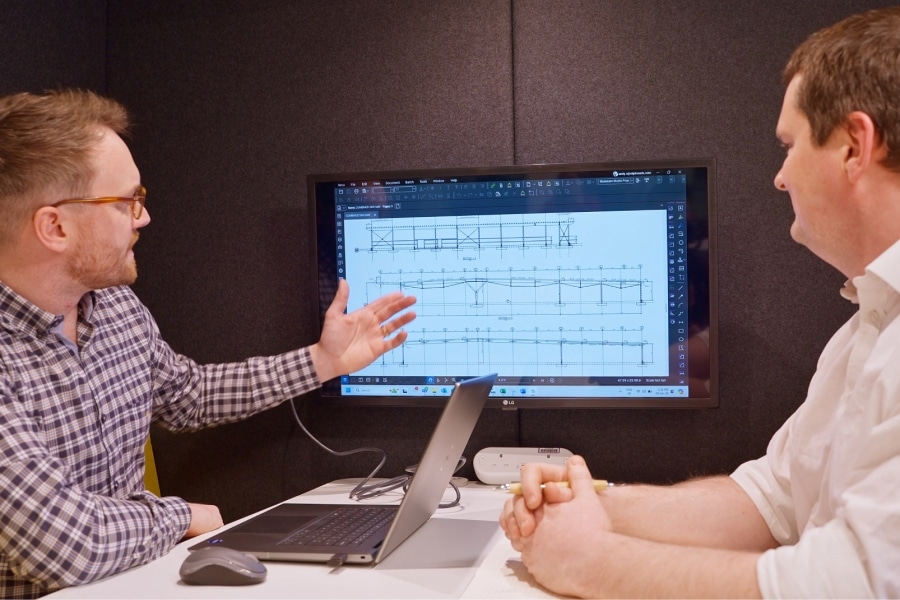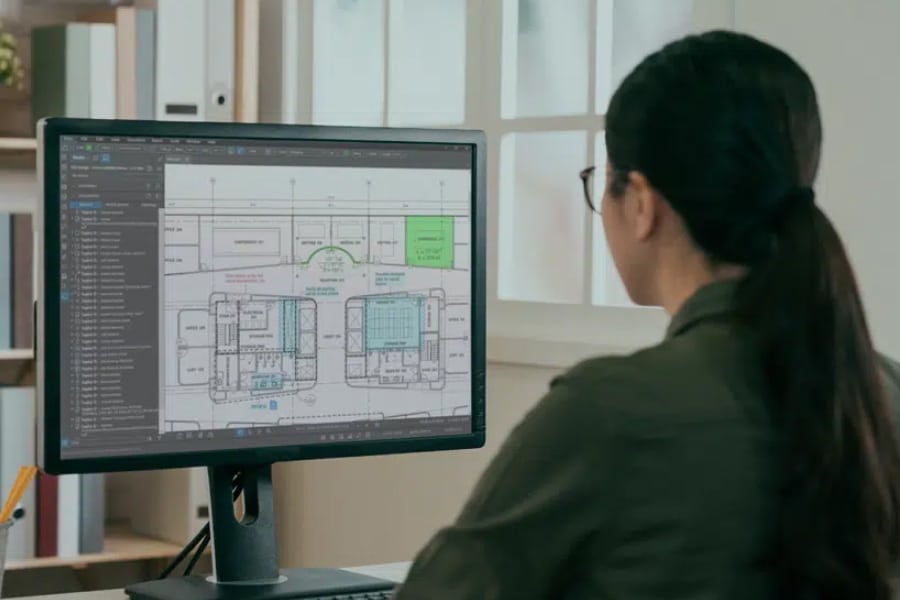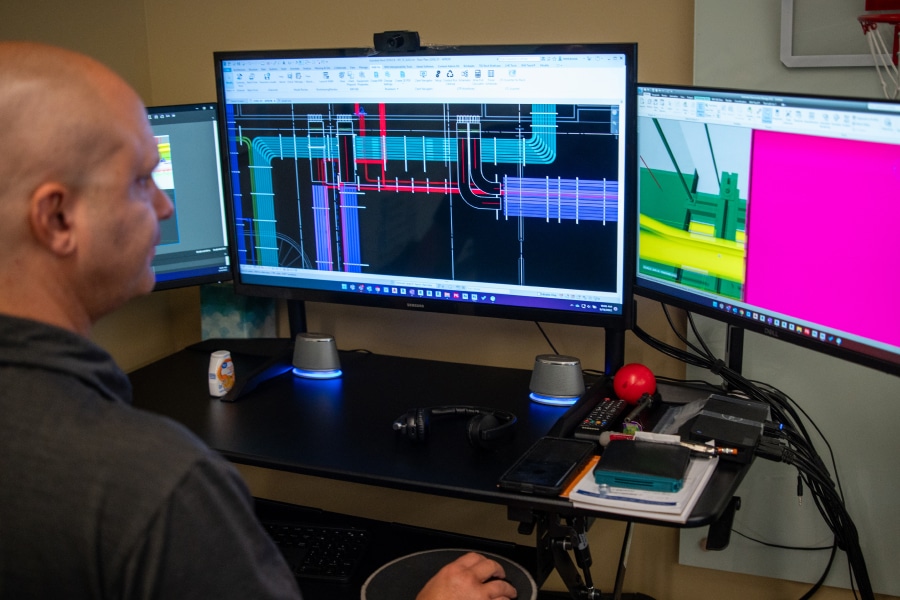Andy Carson, principal structural engineer at Pinnacle Engineering, recalls the frustration of working on a major project before his firm fully integrated Bluebeam into its workflows.
Emails piled up with different versions of the same PDF, each containing conflicting markups from various team members. Client updates were delayed, and tracking changes across multiple disciplines required constant back-and-forth communication. With project timelines growing tighter and remote collaboration becoming more common, Carson and his team knew they needed a more efficient way to work.
That’s when Pinnacle Engineering embraced Bluebeam Revu and Bluebeam Studio, tools that would transform the way the firm approached structural design. No longer constrained by inefficient document sharing, Pinnacle’s engineers began working in real time, improving coordination with architects, technicians and clients.
The result wasn’t just improved efficiency but a fundamental shift in how the firm designed, reviewed and delivered projects.
The Challenge: Overcoming Collaboration Bottlenecks
Structural engineering projects rely on seamless coordination between multiple stakeholders, often across different locations and disciplines. Before adopting Bluebeam, Pinnacle’s workflow had several key inefficiencies.
First, version control was a major obstacle. Engineers and designers were frequently working on separate PDF files, meaning updates were often lost in email threads or had to be manually merged.
Miscommunication was another challenge, as project updates were passed along through emails or meetings, slowing down decision-making. Remote collaboration was limited, with teams unable to work simultaneously on the same document.
Finally, clients lacked visibility into real-time design progress, which often delayed approvals and increased the need for revisions.
These issues were compounded by the increasing complexity of projects and the expectation that design iterations happen quickly. Pinnacle needed a solution that would streamline communication, speed up approvals and improve overall efficiency—all while maintaining the highest level of precision in structural design.
The Solution: A Digital-First Approach with Bluebeam
Pinnacle’s transition to Bluebeam Revu and Studio marked a turning point for the firm. The software provided an all-in-one platform for document markup, collaboration and tracking, allowing engineers to work more efficiently and stay aligned with project stakeholders.
One of the most significant benefits came from Bluebeam Studio Sessions, which enabled real-time collaboration on project drawings. This proved particularly valuable during the COVID-19 pandemic, when teams had to work remotely yet still maintain the same level of productivity.
“Bluebeam was amazingly effective for collaborating on PDFs and sets of drawings remotely,” Carson said. “We really leaned into Bluebeam Studio and Bluebeam Sessions to work in real time from different locations.”
This capability eliminated version control issues and reduced the time spent coordinating updates. Instead of emailing revised PDFs back and forth, Pinnacle’s engineers could work on the same document simultaneously, making markups in real time and ensuring that all changes were immediately visible to the entire team.
Another major efficiency gain came from Bluebeam’s overlay tools, which allowed Pinnacle’s engineers to compare different versions of structural and architectural drawings instantly. Previously, design teams had to manually review drawings on separate screens or even use physical overlays. With Bluebeam, they could now align structural grids with architectural layouts in a matter of seconds, improving accuracy and reducing the risk of design conflicts.
“Bluebeam Revu significantly speeds up decision-making,” Carson said. “In the past, you’d have to compare drawings visually across screens. Now, overlays make it all happen in one place.”
Driving Efficiency with Custom Toolsets
Beyond improving collaboration, Bluebeam also streamlined repetitive tasks within Pinnacle’s workflow. One of the firm’s favorite features is the Tool Chest, which allows users to create and reuse custom markup tools.
For Senior Structural Engineer Ben Thirgood, the Tool Chest has been a game-changer.
“My favorite feature from Bluebeam is definitely the Tool Chest,” Thirgood said. “I’ve put together so many things that I use day-to-day—within 5 or 10 minutes, I’ve got a detail ready.”
This ability to create standardized markups has helped Pinnacle ensure consistency across projects, reduce manual work and speed up the document review process. Instead of drawing the same elements repeatedly, engineers can pull from a library of pre-built annotations and apply them instantly, saving valuable time.
Enhancing Client Engagement and Communication
While Bluebeam has significantly improved internal collaboration, it has also had a meaningful impact on how Pinnacle engages with its clients.
Traditionally, structural engineers worked through a series of design iterations before presenting updates to clients. However, this often led to delays in approvals and misalignments in expectations. By integrating Bluebeam into its client workflows, Pinnacle has been able to provide greater transparency and real-time visibility into the design process.
“The clients that we work with like to see how the design is developing live,” Carson said. “Bluebeam allows that to happen because markups can be done, saved and changed in real time.”
With this new approach, Pinnacle’s clients can review live project updates, make informed decisions faster and provide feedback directly on shared documents. The result: Fewer misunderstandings, faster approvals and a more streamlined workflow for everyone involved.
Measurable Improvements in Workflow Efficiency
Since fully integrating Bluebeam into its workflows, Pinnacle Engineering has seen significant improvements across multiple areas.
- Faster turnaround times: Document tracking and real-time collaboration have cut response times by 10-20%, allowing teams to meet tight deadlines more effectively.
- Greater accuracy in design markups: With overlay tools and the ability to standardize annotations, engineers catch potential issues earlier, reducing costly revisions.
- Improved client engagement: Live-tracked markups and shared access to documents have led to smoother, more transparent communication with clients.
- More efficient internal processes: Features like the Tool Chest have eliminated repetitive work, freeing up engineers to focus on design rather than administrative tasks.
“Because of the reduced lag in issuing information and receiving comments, we’ve typically seen a reduction of 10% to 20% in getting information back,” said associate Andres Gajjar.
These improvements have not only boosted efficiency within Pinnacle’s internal teams but have also enhanced the overall client experience, ensuring projects stay on track and on budget.
Looking Ahead: Scaling Bluebeam’s Impact
With the success of its Bluebeam implementation, Pinnacle is now looking at ways to further leverage automation and integration capabilities to drive even greater efficiency. The firm is exploring how to connect Bluebeam with other project management tools, as well as expanding its use of Bluebeam Studio Sessions for broader collaboration across more disciplines.
“From an engineering perspective, it’s the best PDF markup tool for collaboration in the industry,” Carson said.
For Pinnacle, the transition to digital-first workflows has not just been about keeping up with technology but about fundamentally transforming the way structural engineers work.
A Model for the Future of Engineering Collaboration
Pinnacle Engineering’s journey with Bluebeam serves as a blueprint for firms looking to modernize their workflows. By embracing digital collaboration, real-time markups and client transparency, the firm has reduced inefficiencies, accelerated decision-making and strengthened relationships with stakeholders. For other engineering firms facing similar challenges, Pinnacle’s story proves that adopting the right digital tools can make all the difference.









